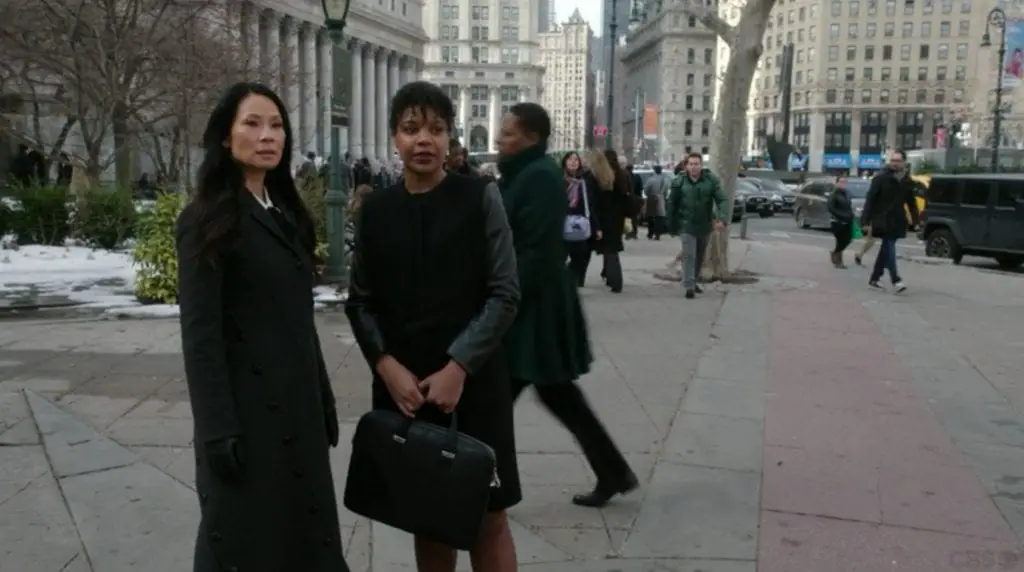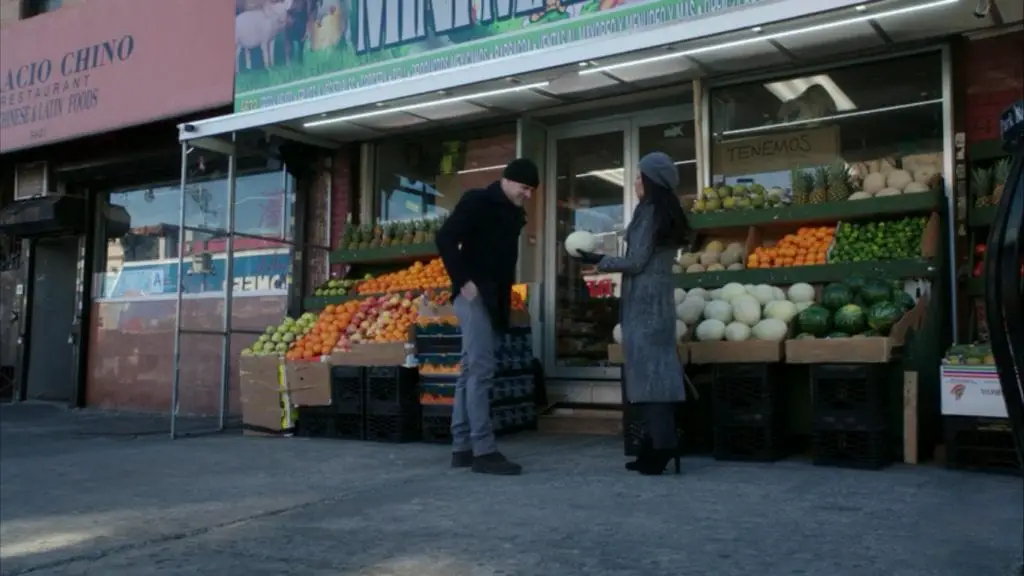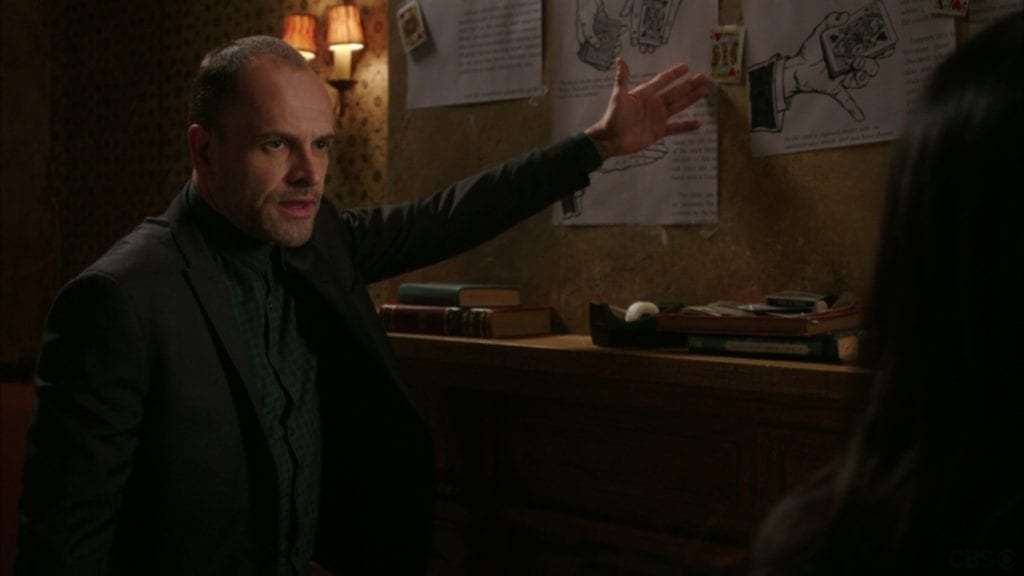Twenty episodes into a somewhat uneven season, it seems like it’s time to start building up to the finale. Before this week’s episode, I would have been sure the finale would center around Shinwell and SBK. But “The Art of Sleights and Deception” takes things in a surprising new direction.
At the start of the episode, Joan enters the precinct to find a heated confrontation involving Bell in the captain’s office. When she has the chance, she naturally asks him what’s happening. He tells her that a man has filed a claim that Bell pulled his weapon on him in an argument. Bell, of course, did not actually do this, but as a result of the claim, he’s now under investigation by IA.
More surprises await Joan at home, when she comes in to find Sherlock apparently being shot in the head by a mysterious woman. He is uninjured and turns his head to show he caught the bullet in the teeth. For a moment I really did wonder if the Myth of Sherlock was enough to convince the writers that he could really do that. Somewhat to my relief, it turns out to only be a magic trick. A street magician going by the handle Razr recently died while performing the bullet catch trick. The official theory is that he swallowed the bullet and choked on it, but Sherlock believes the bullet was coated in poison.
Razr’s real name was Claude Rysher, and Sherlock turns out to be right about the poison. It was murder, not an accident. Jolockbell head out to Rysher’s apartment to look for Clues™, of which they find two. First, the lock to his apartment was picked by a left-handed individual. Secondly, there’s a note there from someone called “Anubis” accusing Rysher of stealing magic tricks.
Joan decides to investigate the man that made the claim against Bell. His name is Titus Gorham and his story is, in her opinion, a little suspiciously detailed, as if he was coached on what to say by a cop. She asks Bell’s DA girlfriend, Chantal, to help her out with the investigation.

Anubis turns out to be a female magician that used to date Rysher. After they broke up, she heard that he was using a bunch of her tricks. But she swears that she didn’t kill him over it and instead gives them a new lead. Rysher used to play poker and used his sleight of hand tricks to cheat. Maybe someone got angry over being cheated.
Sherlock finds Rysher’s old poker haunt and the man who runs the game admits that he knew that Rysher was cheating. But Rysher wasn’t indiscriminately cheating. In fact, he only targeted one individual and won a small fortune off of him.
Rysher’s target turns out to be a banker. He had no reason to kill Rysher, he says, because he successfully paid off his debt. But not with money; Rysher wanted information. He asked for all of the bank records from 1963 connected to a now-defunct publishing house called Turnleaf. Not only is this oddly specific, but the detectives didn’t find any of these records at Rysher’s home. The killer must have taken the records after they poisoned Rysher. The key to the mystery must be concealed in the files.
It turns out that Turnleaf published one book of particular interest in ‘63: a magician’s how-to guide called The Art of Sleights and Deception. Rysher had a copy, and any magician would probably be familiar with the book. More importantly, a significant mystery surrounds the book. The author published under the pseudonym of Walker Elmsley, and even all this time later, no one knows Elmsley’s real identity. A famous and eccentric magician, Quinn Malcolm, has offered a two million reward for anyone able to uncover it. If Rysher was close to the prize, maybe someone murdered him to steal his information and win the prize.
Sherlock arranges for them to meet Malcolm outside a greengrocer’s stand, but when they arrive, he isn’t there. However, he texts Sherlock asking Joan what her favorite melon is. When she answers honeydew, he asks they pick a fruit from the stand. Joan does, and Sherlock promptly smashes it on the ground. Inside is a flash drive. Sherlock is impressed. Joan is forced to pay.

Meanwhile, Bell has become convinced that the cop behind Gorham’s false claim must be Chantal’s unpleasant ex-husband, Roy. Quick recap: Bell and Roy have had it out for each other since they got into a barroom brawl designed to derail Chantal’s career. After that incident, Bell determined that Roy’s disability claim was fake and threatened to out him if he ever bothered Chantal or Bell again.
Bell goes to confront Roy. He doesn’t admit to being behind Gorham, but his denials aren’t exactly convincing either. He makes a point of telling Bell that he’s had his disability claim further confirmed. That threat won’t work anymore.
The honeydew flash drive contains Malcolm’s records of all the most obsessed competitors in the quest to find Elmsley. Sherlock and Bell interrogate one woman who was attempting to find Elmsley by tracking down the illustrator of Sleights and Deceptions, but only discovered that the illustrator’s name was also a pseudonym. She has an alibi for Rysher’s murder, but her discovery gives Sherlock an idea.
Unsurprisingly, Sherlock decides to try and find Elmsley’s real identity himself. There’s a cute moment where Joan jokingly asks if, as partners, they’ll split the prize money. Without a second thought, he says she can have it all. I know Sherlock never really worries about money, but that was still sweet.
Sherlock also focuses on the book’s illustrations. He notices a quirk in the drawings of card tricks. All of the face cards are reversed from what direction they should be looking, as if the illustrator was not drawing someone else doing the tricks, but watching himself do the tricks in the mirror and drawing that. This implies that the illustrator and Elmsley are actually the same person.

Riffing off this, Joan notices that the hands in the illustrations have line on the wrists. It could be part of the illustration style, or it could be a scar. Such a distinctive scar would most likely come from surgery to correct carpal tunnel. But in the early sixties, the only way for a person to have that scar would be for them to have participated in an experimental medical trial. If they can find records from these trials, they might be able to find Elmsley.
Unfortunately, when Sherlock tries to track down the records, he finds that the warehouse they were stored in was burned down. Significantly, it was ruled arson and the lock was picked by a left handed person. The arson occurred shortly after Quinn announced his contest. Maybe Rysher wasn’t killed by someone trying to find Elmsley’s identity but by someone trying to hide it.
Turnleaf Publishing, the company that published Sleights and Deception, is no longer active, but it was purchased by a company called Farraday. Jolockbell heads over to Farraday to speak to a Farraday agent. They theorize that because Elmsley’s identity was unknown, Turnleaf and then Farraday were saved from having to pay royalties on the successful book. But if the author was revealed, he or his heirs could claim these royalties. Maybe someone at Farraday killed over the money.
But the Farraday rep, Ballard Clifton, denies this. Not only does Farraday know the identity of Elmsley and his heirs, in fact, Clifton is one of those heirs himself. His grandfather, a man named Albert Lang, wrote and illustrated the book. Farraday has been paying them all along. Stumped on this front, the detectives instead propose that revealing Elmsley’s identity would ruin the mystery around his pseudonym and negatively affect sales. But Clifton insists the company believes that a big reveal would be good publicity and boost sales. Farraday seemingly doesn’t have any reason to want to kill over the secret.

Bell finds a different lead instead. Rysher was apparently bidding on the darknet in an auction for a book written by a Nazi doctor who worked in a concentration camp. He won the auction, prompting Joan to say she’s suddenly a little less invested in the case. But a lead is a lead is a lead, so they bring in a man who lost to Rysher in the bidding war.
The suspect is a thoroughly unpleasant Neo-Nazi, but he denies killing Rysher. The book wasn’t so rare that he was unable to find another copy, so what motive would he have? To prove his innocence, he gives the detectives his new copy of the book.
Chantal and Bell discuss the Roy issue. Bell is positive Roy is behind Gorham but is unable to prove a connection between them. But when Chantal offhandedly mentions a detail of Roy’s past, she unlocks the case for him.
We’ve reached the wrap-up part of the episode, so the Nazi book does the same thing for Sherlock. I won’t give it away too much but let’s just say that the illustrations of the horrible Nazi book turn out to be awfully familiar.
Joan and the captain, acting on their new information from Bell, interrogate Gorham and get him to confess he made up his claim and was coerced by Roy. Yay, right?
Anyone paying attention to the background music in the last minutes is sure to realize it’s definitely not yay. When the music gets that dramatic you know something is about to go down. It’s too early yet to judge this new twist, but it’s certainly going to take the show in a new direction.

